MILITARY RAILROADS
OF THE NEW YORK METROPOLITAN
AREA:
NAVAL SUPPLY DEPOT & DRYDOCK - BAYONNE
MILITARY OCEAN TERMINAL - BAYONNE "MOTBY"
BROOKLYN NAVY YARD ANNEX - BAYONNE
Bayonne, New Jersey
.
.
updated:
|
|
update summary |
date |
| Conrail 1981 maps added to trackage | 26 May 2019 |
| page created | 24 May 2019 |
.
.
.
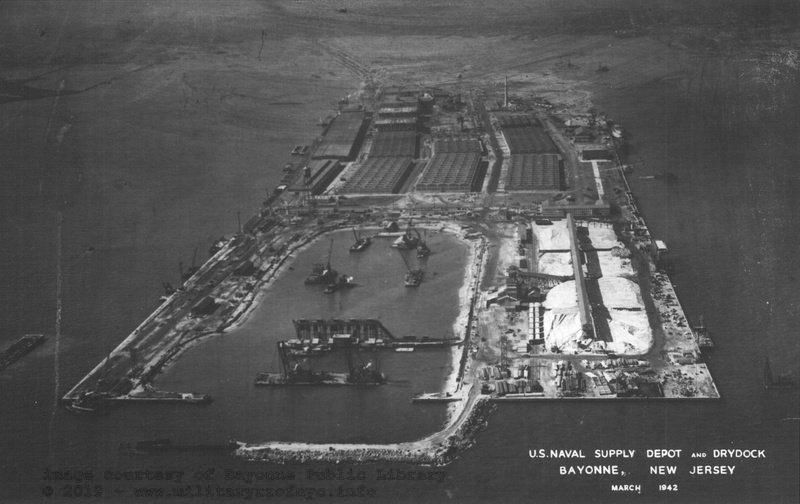
US Naval Supply Depot & Drydock - Bayonne, NJ - under construction - March 1942
.
.

Overview
.
The Naval Supply Depot - Bayonne which would later become the Military Ocean
Terminal Bayonne or "MOTBY" (would that be pronounced MAHT-bee or
MOAT-bee?); was conceived prior to World War II to meet the growing
need
for an integrated shipping depot.
The Depot was located on the western side (New Jersey shoreline) of Upper New York Bay and this facility has the unique distinction of being administered to by two different branches of the US military: the US Navy from 1942 to 1967 and the US Army from 1967 to 1999.
Contemporary resources on the internet state the plans for the facility came about in 1932, but I have found references to a plan dating back to 1920 in "The Port of New York" by Thomas Edward Rush. In this book, it mentions the development of a new water terminal in Bayonne. I found yet a second reference in a trade journal "Port of New York and Ship News", December 1923 issue, wherein it mentions "and possibly a new $150,000,000 marine terminal at Bayonne, NJ."
Needless to say, it was decided that a new facility was needed. In 1932, several local businessman formulated a plan to build the vast Bayonne Port Terminal. The location was in Upper New York Harbor and convenient to all shipping piers up and down both shores of the Hudson and East Rivers.
In 1939, this plan was finalized and construction began with the dredging and filling a huge peninsula. The only structure at that time was a steel frame waterside transit shed. As this is taking place; the cloud of war is developing in Europe and the United States Navy found itself wanting of a location on the Eastern Seaboard for a deep water port. A deep water port is one that offers 20 feet or deeper (draft) berths for ships. And the location of new Terminal at Bayonne could offer berths 28 to 40 feet deep at Mean Low Water.
With its close proximity to the Brooklyn Navy Yard and the myriads of various military support installations scattered throughout the Metropolitan NY area, as well as the petrochemical refineries of New Jersey, it was a fortuitous point in time and a very convenient location. Being on the mainland (New Jersey) side of New York Harbor, the location had the benefit of being connected to the Class 1 railroads: Pennsylvania, Central Railroad of New Jersey, Lehigh Valley, Baltimore & Ohio (among others); and allowed unbroken movements (without the need for carfloating) from across the United States, to be received intact.
In October 1940, Navy appropriations were made and field work commenced at the Port Terminal in March 1941 and for the outer portion of the peninsula, a dock and repair facilities was added and for the inshore end, the supply depot.
Anything and all was shipped out of the depot, including but not limited to: automobiles, jeeps, trucks, tanks, boats, locomotives, railway rolling stock, artillery pieces, light and heavy tanks, fighter planes, fuel, chemicals, motor oil, spare parts for everything previously mentioned not to mention all the incidentals ranging from Quonset Huts to GI socks.
Newly built and commissioned vessels from the Brooklyn Navy Yard only needed to sail across New York Bay to be provisioned at Bayonne, NJ.
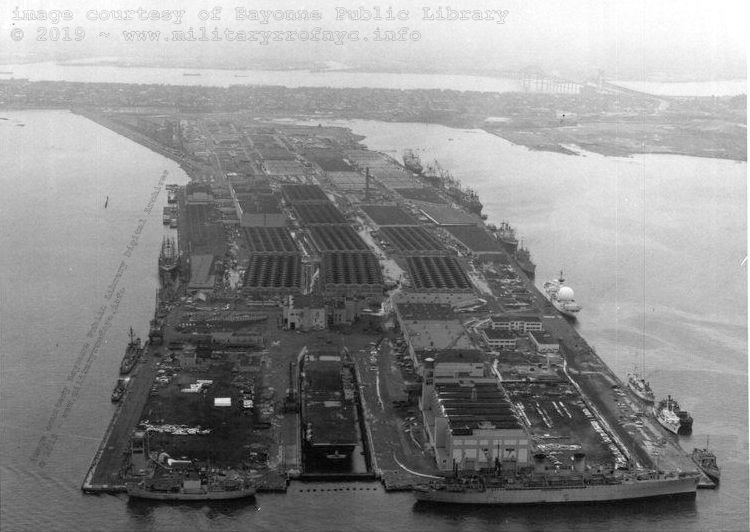
.
Following World War II, the Depot remained an important strategic asset. All the material above of value that had been shipped overseas, and that of which that had not been shot or blown up, wrecked, expended or abandoned in place; now needed to be returned. And there was a lot of that. The Supply Depot found another use as a Surplus Depot. A lot of the locomotives (and other vehicles) built for overseas duty came home and were sold outright or auctioned off here. More than a few ex-military locomotives from the European Theater of Operations were repatriated through the Supply Depot. Everything from the diminutive 0-4-0T industrial steam switchers to 2-8-2 Mikados to the newer diesel-electric Whitcomb 65 ton centercabs.
And with a lot of Naval vessels now out of work, Bayonne Mayor J. J. Donovan lobbied the Navy to locate the Atlantic Reserve Fleet a/k/a the "Mothball Fleet" in Bayonne. Several trips by Washington officials, including the Secretary of the Navy Frank Knox, had the desired result. The Reserve Fleet would be based at Bayonne.
While under Department of Navy control, the facility served as the primary East Coast distribution point for ordnance, electronic and stored war reserve materials. It also served as a storage and issue point for petroleum products, supplied fresh provisions and bulk petroleum to ships, and served as a storage point for National Stockpile Material.
The Naval Supply Depot - Bayonne served through the Korean Conflict (September 1950 - 27 July 1953) and it would continue to serve the Navy until 1967, when it was transferred to the US Army command structure. The facility would become known under Army command was "MOTBY": Military Ocean Terminal - BaYonne, which was established in July 1965 and of which originally started out as a tenant of the U.S. Naval Supply Center. And at this time of transfer, America was in a new war; in Vietnam, Republic of. (1955-1975). And war matériel had to get to the Pacific Ocean in increasing amounts as the war escalated.
Nothing really changed about the mission of MOTBY. Pretty much only the color of the uniforms: from Navy Blue to Army Olive Drab. Once a cargo arrived at MOTBY, it could be placed directly into secure warehouses or into uncovered, but fully secure staging areas. All types of cargo, from MCI's (Meal, Combat, Individual - the replacement of the WW2 C-Ration) to M48 and M60 Patton Tanks to Bell UH-1 "Huey" Helicopters arrived at MOTBY for shipment overseas.
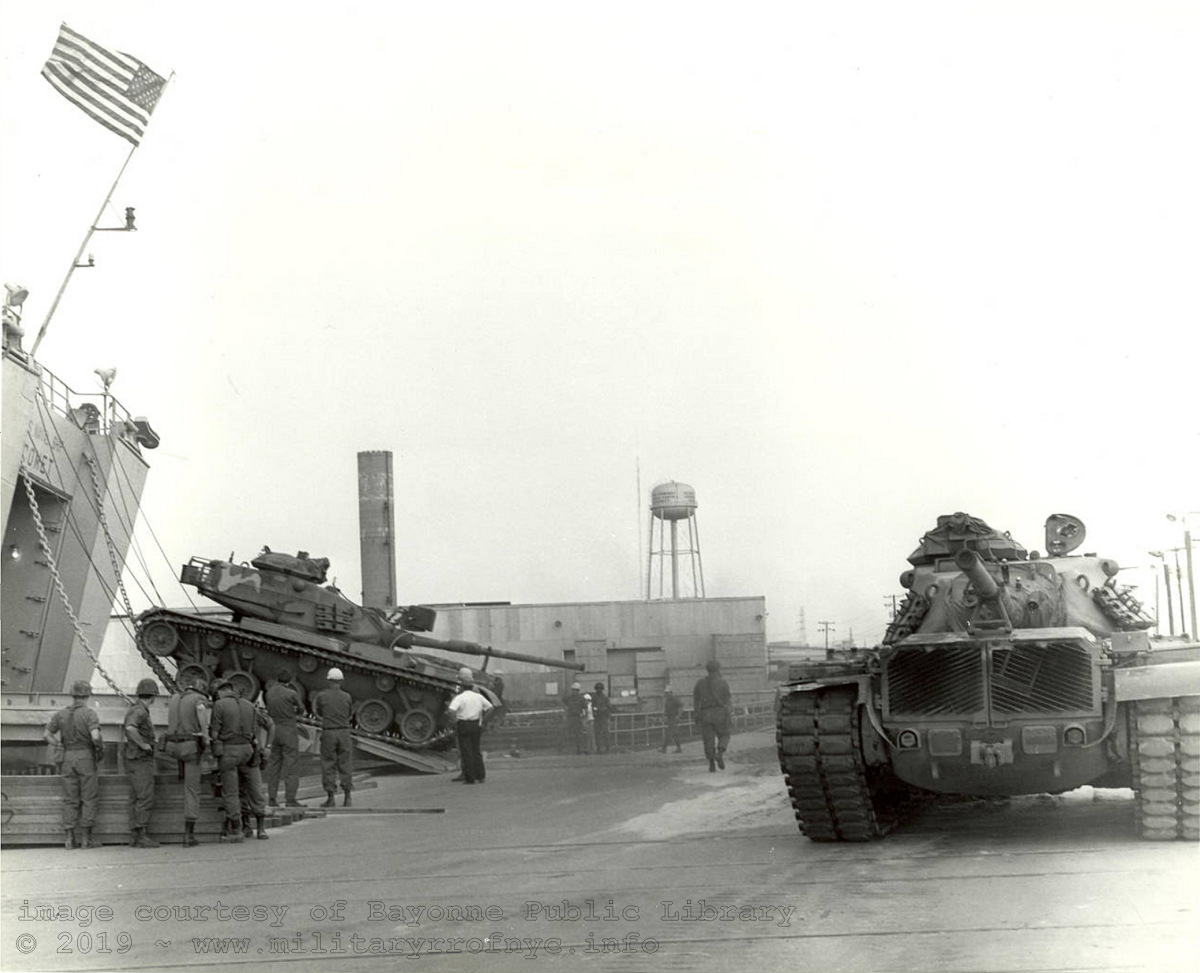
M60 Patton Tanks being unloaded - 1980
US Army photograph
image courtesy of Bayonne Public Library Digital Archives
© 2019 ~ www.militaryrrofnyc.info
added 27 May 2019
.
.
The withdrawal from Vietnam kept the facility busy. And it would stay busy right through the 1970's and 80's, to Operations Desert Shield and Desert Storm (a/k/a First Gulf War - 02 August 1990 – 28 February 1991). MOTBY's capability was used to load heavy, outsized weapons such as the M1A2 tank and the MIM-104 Patriot Missile, a surface-to-air defense missile made famous for protecting our ground troops during Desert Storm. Not to mention all the peripherals necessary to the operation and maintenance of those weapons: radar sets, electronics, wheels, generators, et al.
Troops of those U.S. military units that operated in Somalia in 1993 and Haiti 1994-1995, also embarked from MOTBY.
Towards the 1990's, the operational name of the facility was changed to the 1301st Major Port Command (formerly Military Ocean Terminal -Bayonne).
It would be short lived, as in 1995 the US Base Realignment and Closure Directive ("BRAC") included MOTBY in its list of closures. (It had been spared on numerous dates in previous versions of BRAC). So the wheels were set in motion to relinquish the facility to civilian ownership. This officially took place in 1999.
Since transfer to civilian ownership; the location has been renamed "The Peninsula at Bayonne Harbor" and is now the home to a privately operated shipyard and drydock; as well as Cape Liberty Cruise Ship Terminal. This location is also being redeveloped into a variable use waterfront community of residential, light industrial, commercial, and recreational space. Construction is to take place in phases, with one area of housing currently completed.
The former installation is currently maintained by the City of Bayonne. The City of Bayonne Police Department occupies office space in Building 82 for a portion of that city’s police force, administrative staff, and maintenance staff. The Fire Department for the City of Bayonne operates a fire station in Building 44B, and the U.S. Coast Guard operates an active facility located at Areas 75 and 85.
Facilities
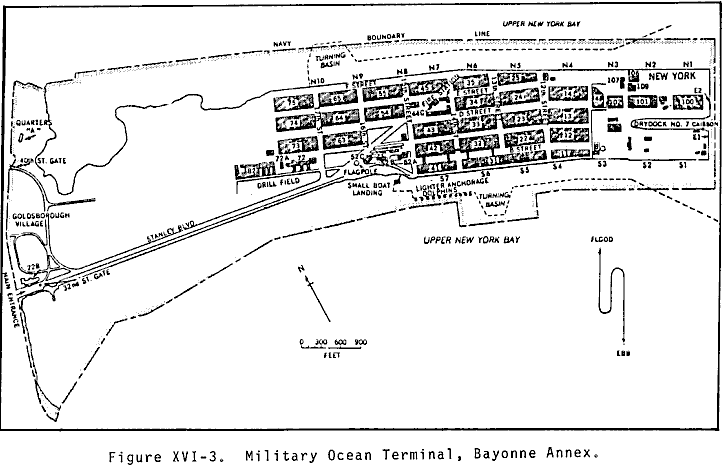
Facilities Map Military Ocean Terminal - Bayonne, NJ
from Department of the Army - Defense Base Closure and Realignment Commission
University of North Texas Digital Archives
annotated version: © 2019 ~ www.militaryrrofnyc.info
added 24 May 2019
.
.
By May 1941, the Navy found it necessary to issue supplementary contracts for the construction of additional warehouses, transit sheds, and other facilities.
And as we all know from our history books, the United States became directly involved in World War II in December 1941. The Naval Supply Depot Bayonne military base was commissioned by the Navy in 1942 as a logistics and repair base and named US Naval Supply Depot - Bayonne, a/k/a "NavSupDep". I have also found references to it, called Brooklyn Navy Yard Annex. By 02 August 1942, the Navy issued expansions on the existing contracts to increase storage capacities to keep pace with the rapidly expanding wartime Navy.
By V-J Day (Victory in Japan) on 02 September 1945, the Bayonne Naval Supply Depot could offer 3,802,000 square feet of covered storage space. 26 major buildings were built, most permanent. One of those buildings, the original 2 story transit shed. The Navy added 4 more transit sheds, 19 six-story storehouses, 2 of which equipped for heavy materials; 1 seven-story storehouse and 1 single story cold storage warehouse.
One of the unique design features about the storehouses at Bayonne was the barrel arch roof construction used in eight of the storehouses.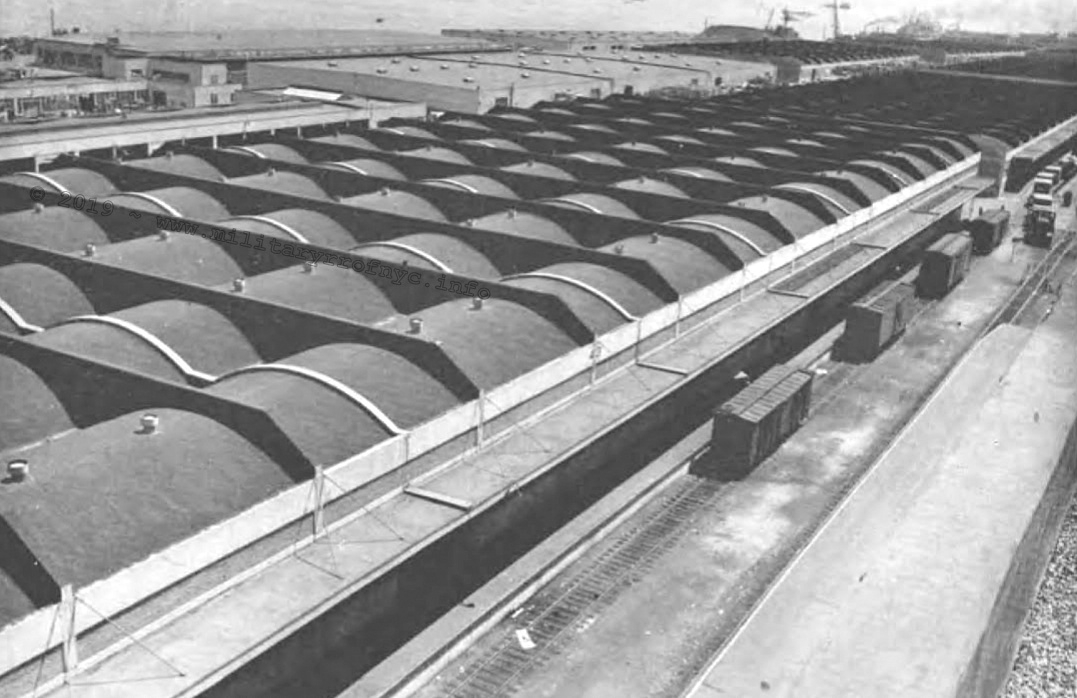
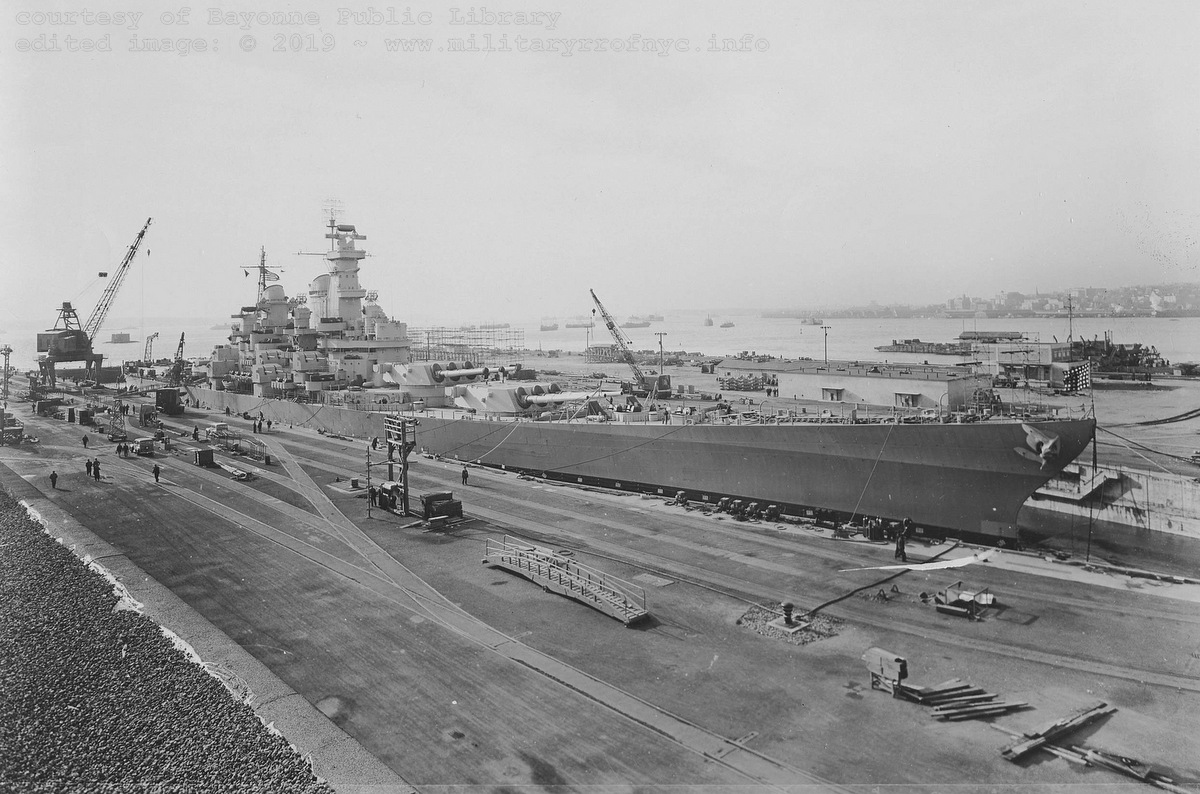

| c/n: | 27594 | 27755 | 27585 |
| ship date: | 5/27/1944 | ||
| model: | B-B-90/90-4GE733 - center drop cab | ||
| weight: | 45 ton | ||
| gauge: | standard | ||
| wheel diameter: | 33" | ||
| prime mover: | Caterpillar D-17000 (x2) | ||
| rating: | 380hp | ||
| US Army #8516 Transferred to European Theater of Operations (France, Austria & Germany): 7/1944 Returned to United States: 5/1945 to Europe, 1970? |
US Army #8578 | US Army 8507 Transferred to Great Britain Transferred to European Theater of Operations (France, Austria & Germany): 5/1944 Returned to United States; 5/1945 to Fort Jackson, Columbia SC to Europe, 1970? | |
.
The following information is courtesy of the U.S. Department of Transportation's MARAD Administration website:
The GTS (gas turbine ship) Admiral W. M. Callaghan is an early roll-on/roll-off vessel and the first all-gas-turbine vessel constructed for the U.S. Navy. Built at Sun Shipbuilding and Dry Dock in Chester, PA; the Admiral W. M. Callaghan was launched on 17 October 1967 and went into service on 19 December 1967 under charter to the Military Sea Transportation Service (MSTS), the predecessor to the U.S. Navy’s Military Sealift Command (MSC).
Although primarily employed as a RO/RO, the Admiral W. M. Callaghan is also fitted with conventional cargo gear for lift-on/lift-off operations. The ship is fitted with two 120-ton capacity booms and twelve 5-10 ton capacity booms serving the cargo holds. The ship has 167,537 square feet of vehicle storage space arranged on several decks, with internal ramps and watertight doors providing access to the lower decks and between the cargo holds. Vehicles are loaded and unloaded through four side ports and the stern ramp, with a throughput of approximately 750 vehicles per day.
The Admiral Callaghan was originally fitted with two Pratt and Whitney FT-4 engines of 25,000 shaft horsepower each, providing a service speed of over 20 knots. Unfortunately, the FT-4 engines experienced many technical problems, and by 1969 they were replaced with the first production examples of the General Electric LM-2500 marine gas turbine. The LM-2500, a derivative of GE’s CF-6 aviation engine, has since become ubiquitous in U.S. naval service, with hundreds of examples in all manner of combatant craft and auxiliaries.
Further images and info about the Admiral Callaghan.
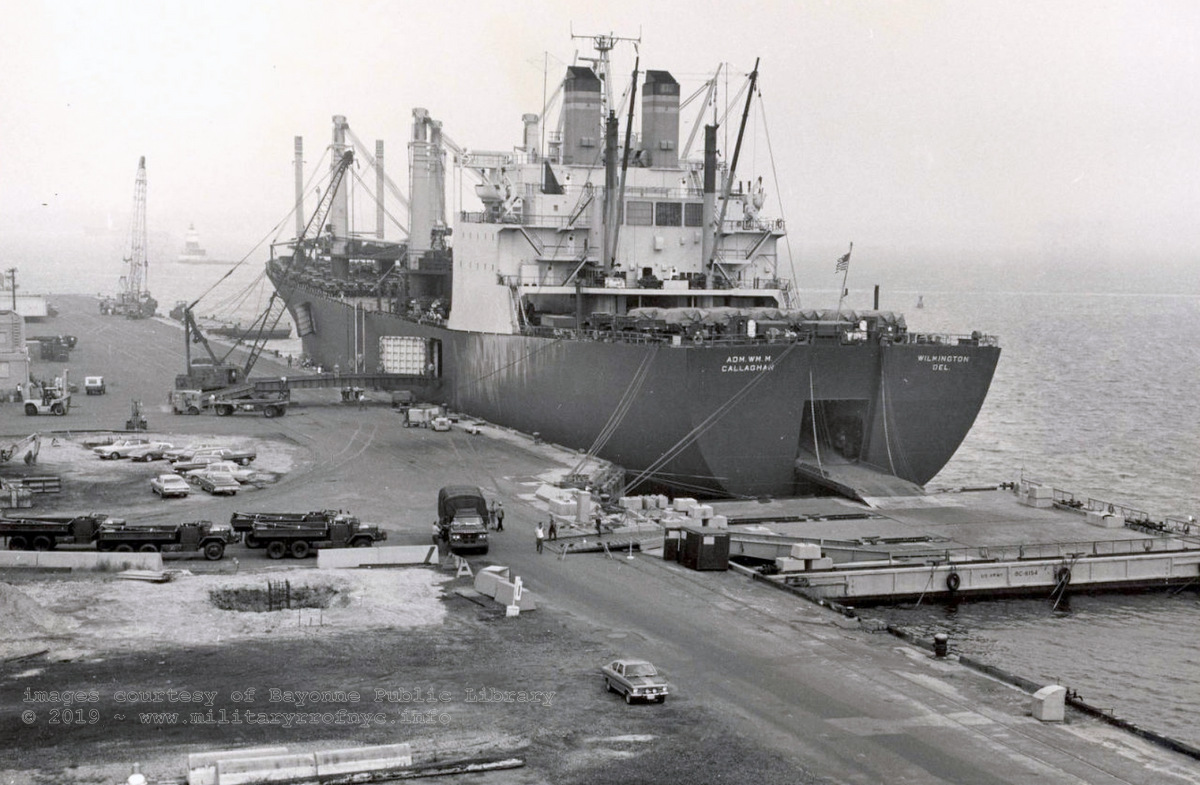 | 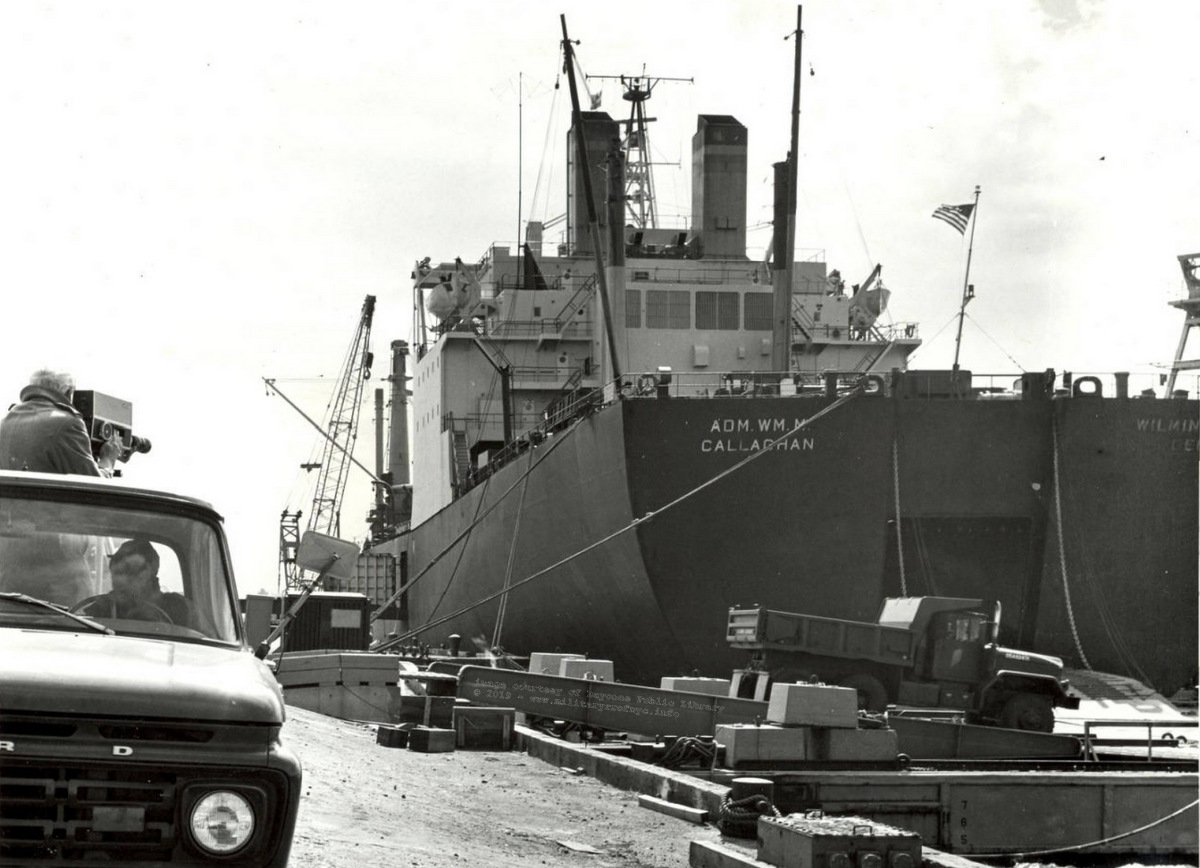 |
| Note
the use of the bridge ramp in conjunction with a barge (US Army BC-6154 - barge, dry
cargo) used as a floating stage for vehicles to access the rear ramp of
the ship. These barges could be floated to any position in any quantity to service as many ships as necessary moored to the piers, allowing multiple ships to be loaded/unloaded as necessary. both images: 1971; US Army photographs image courtesy of Bayonne Public Library Digital Archives © 2019 ~ www.militaryrrofnyc.info added 25 May 2019 | |
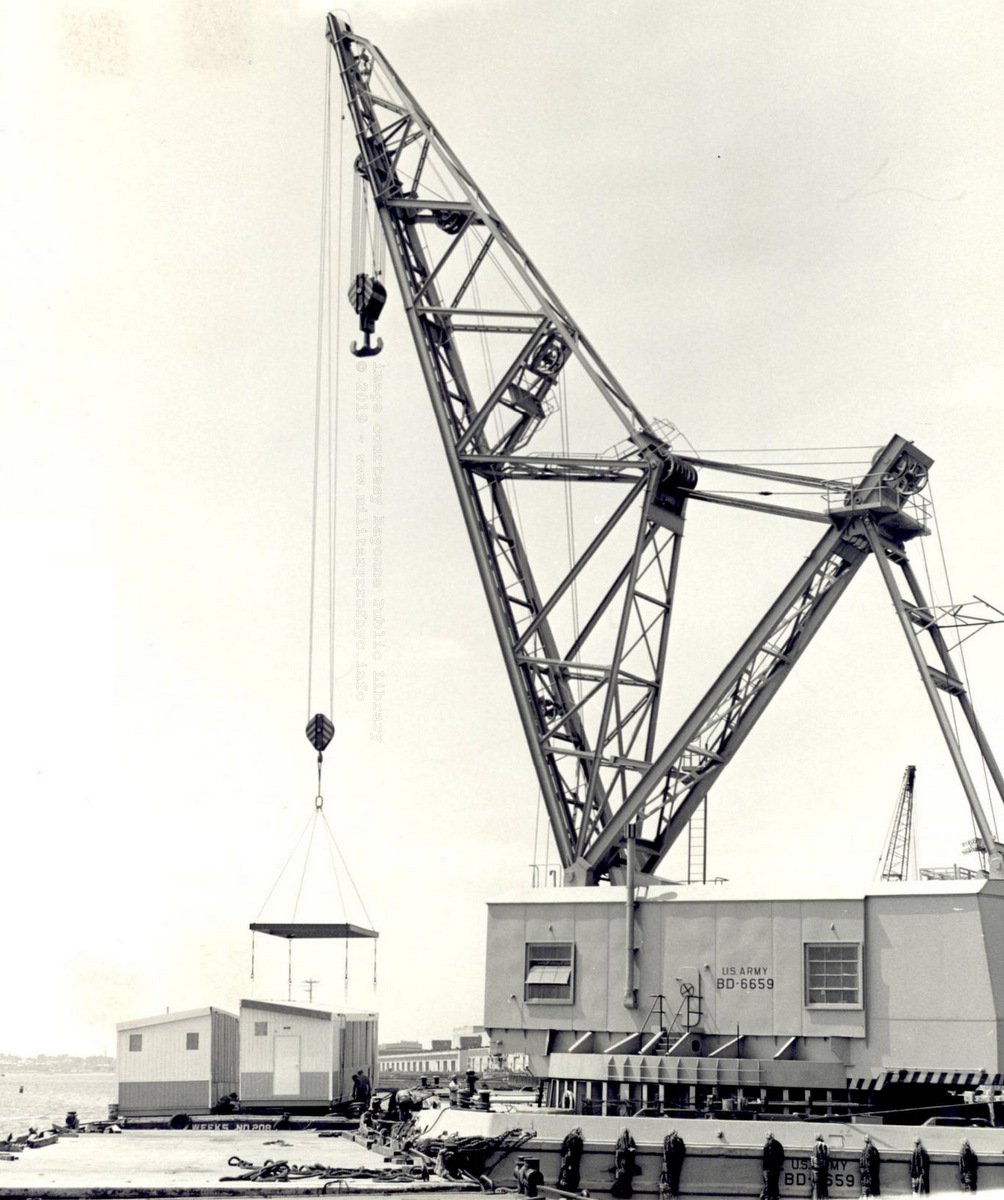
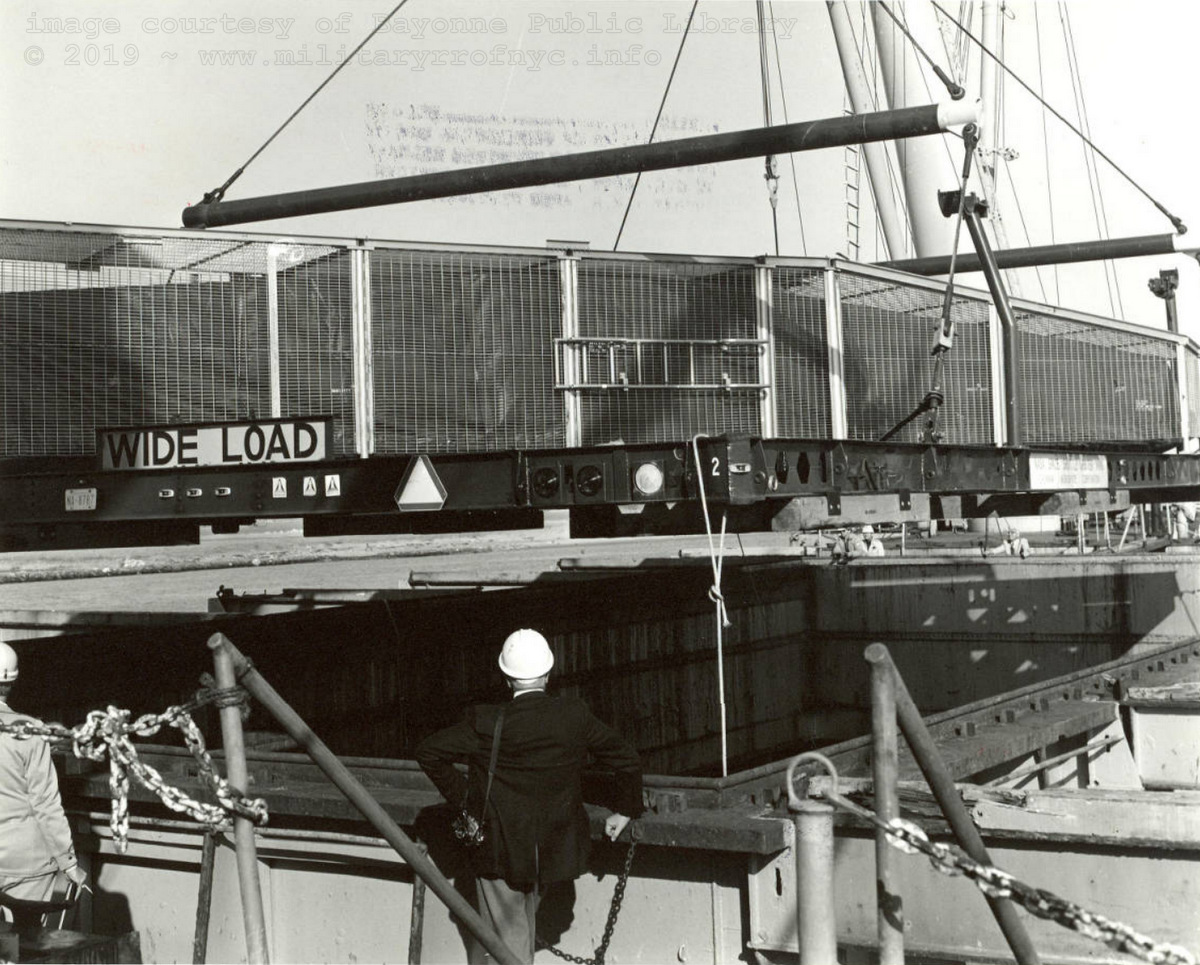
Trackage & Rail Service
.
The rail network within MOTBY was directly connected to the mainland US rail network via the Lehigh Valley Railroad's National Dock Branch, (which would be further defined later in time as Conrail's Harbor Industrial Branch) as well as the Central Railroad of New Jersey's Bayonne Industrial Track. Both LV and the CRRNJ had their own major terminals in the area, as well as interchange with other northeastern Class 1's, including the Pennsylvania Railroad just a few miles north at Greenville, and New York Central 7 miles north at Weehawken.
To give you an idea of the numerous railroad interchange availabilities as well as surrounding railroad yards and industrial facilities convenient to MOTBY; I have zoomed in on the appropriate area from a map in my collection. The location of MOTBY is highlighted in yellow.
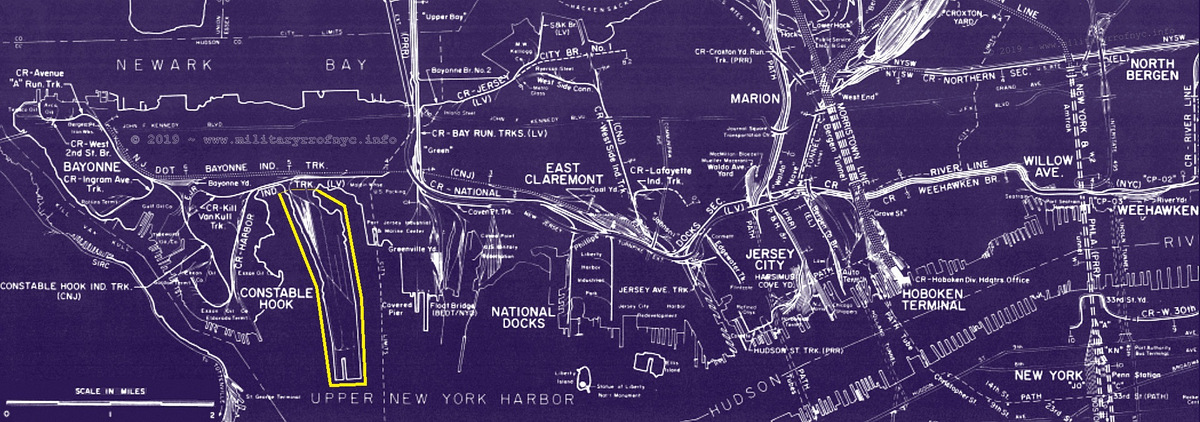
Conrail - Newark, Jersey City & Northern New Jersey Railroads & Industries - 1981
North is to the right.
authors collection - © 2019 ~ www.militaryrrofnyc.info
added 26 May 2019
.
.
This direct interchange allowed any freight from anywhere in the United States to be received directly at MOTBY. It made for very convenient receiving of complete military units for overseas shipment.
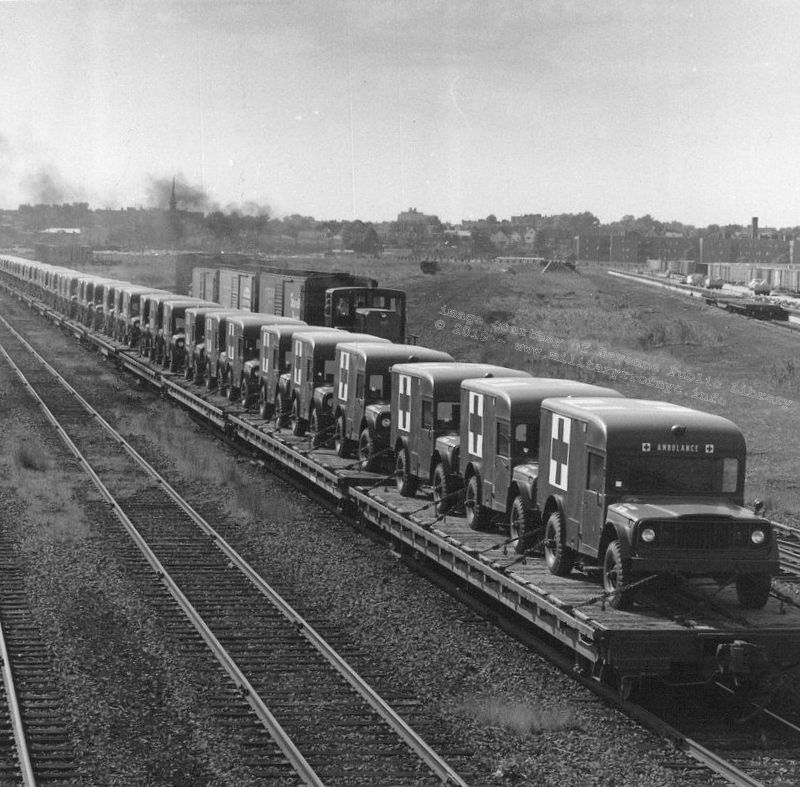
US military ambulances arriving at Military Ocean Terminal - Bayonne getting shifted by one of the base locomotives - undated
Number cannot be discerned, but it is a GE 80 tonner. Note drop center flat car on right edge of image.
US Army photograph
image courtesy of Bayonne Public Library Digital Archives
© 2019 ~ www.militaryrrofnyc.info
added 24 May 2019
.
.
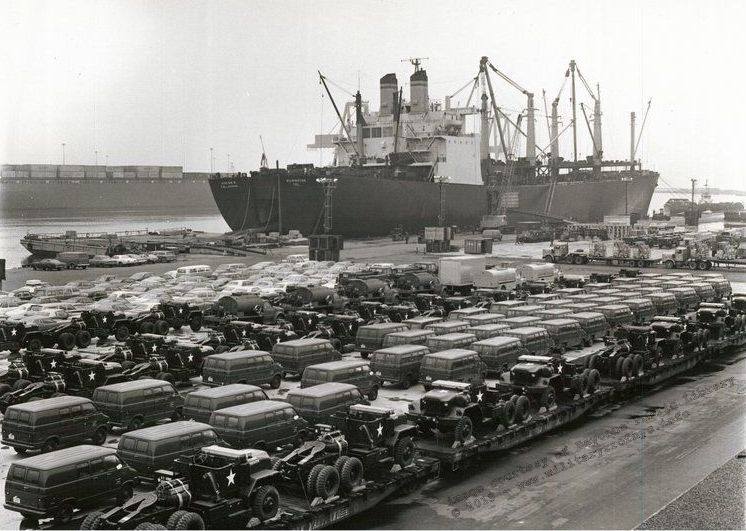
US
military servicemembers' personal vehicles "POV's", assorted US
military vehicles, and US military trucks on flatcars - 1973
in outdoor staging area await loading for shipment overseas.
US Army photograph
image courtesy of Bayonne Public Library Digital Archives
© 2019 ~ www.militaryrrofnyc.info
added 24 May 2019
.
.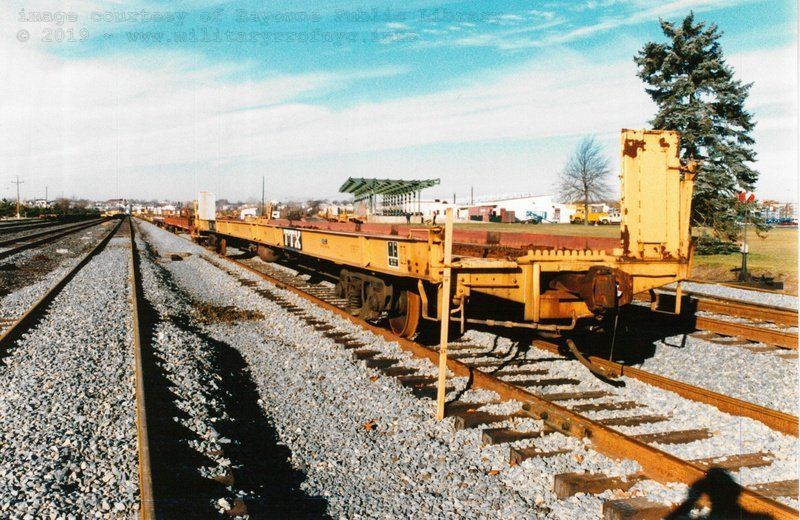
TTX vehicle flatcars in Military Ocean Terminal - Bayonne, NJ.
US Army photograph
image courtesy of Bayonne Public Library Digital Archives
© 2019 ~ www.militaryrrofnyc.info
added 24 May 2019
.
.
Detailed railroad facilities have not been well documented and are lacking. Cursory examination via satellite imagery and mapping tools reveals an extensive railyard as the southwestern quadrant of the terminal, with tracks leading to both north and southside berths.
We are able to witness that by the 1947 USGS Topographical map, trackage to Naval Supply Depot was rudimentary at best.
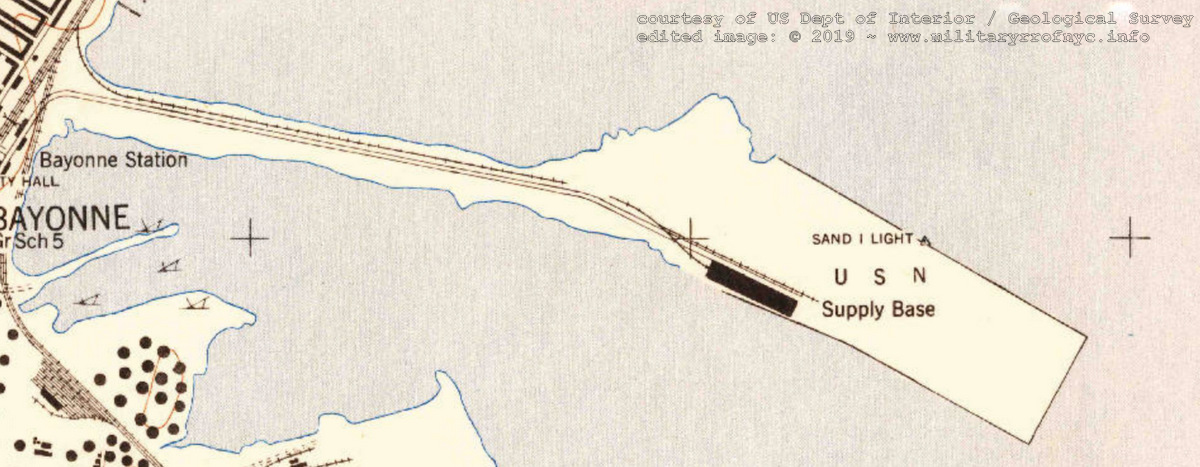 - 1947 edition
- 1947 edition
enlarged sectional image of Military Ocean Terminal Bayonne: © 2019 ~ www.militaryrrofnyc.info
added 24 May 2019

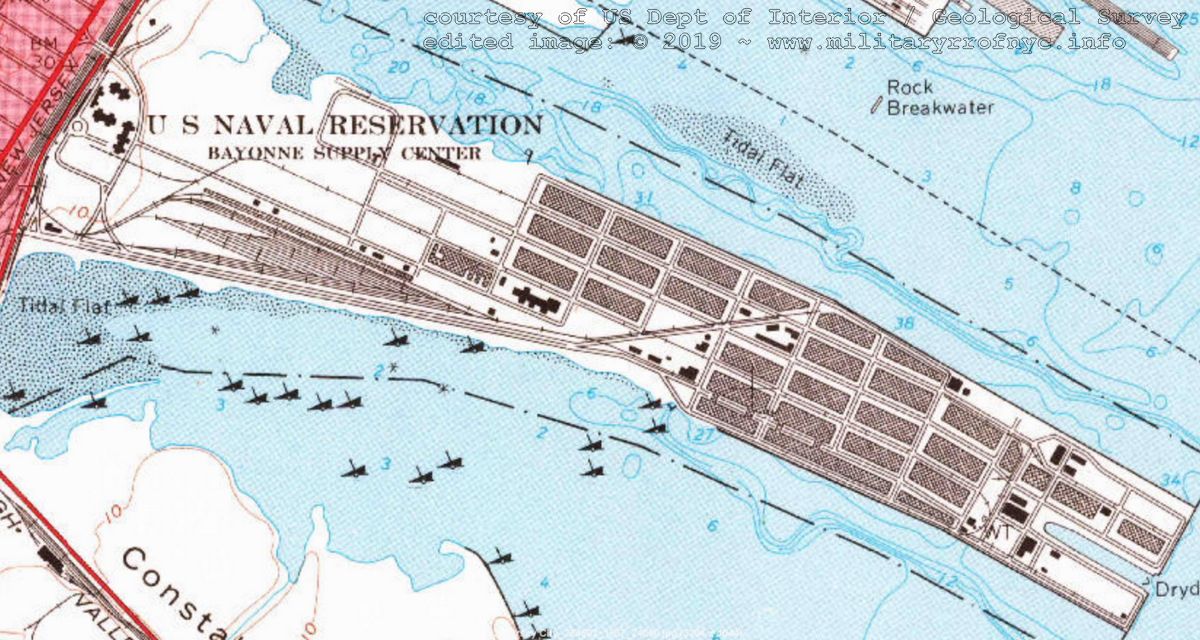
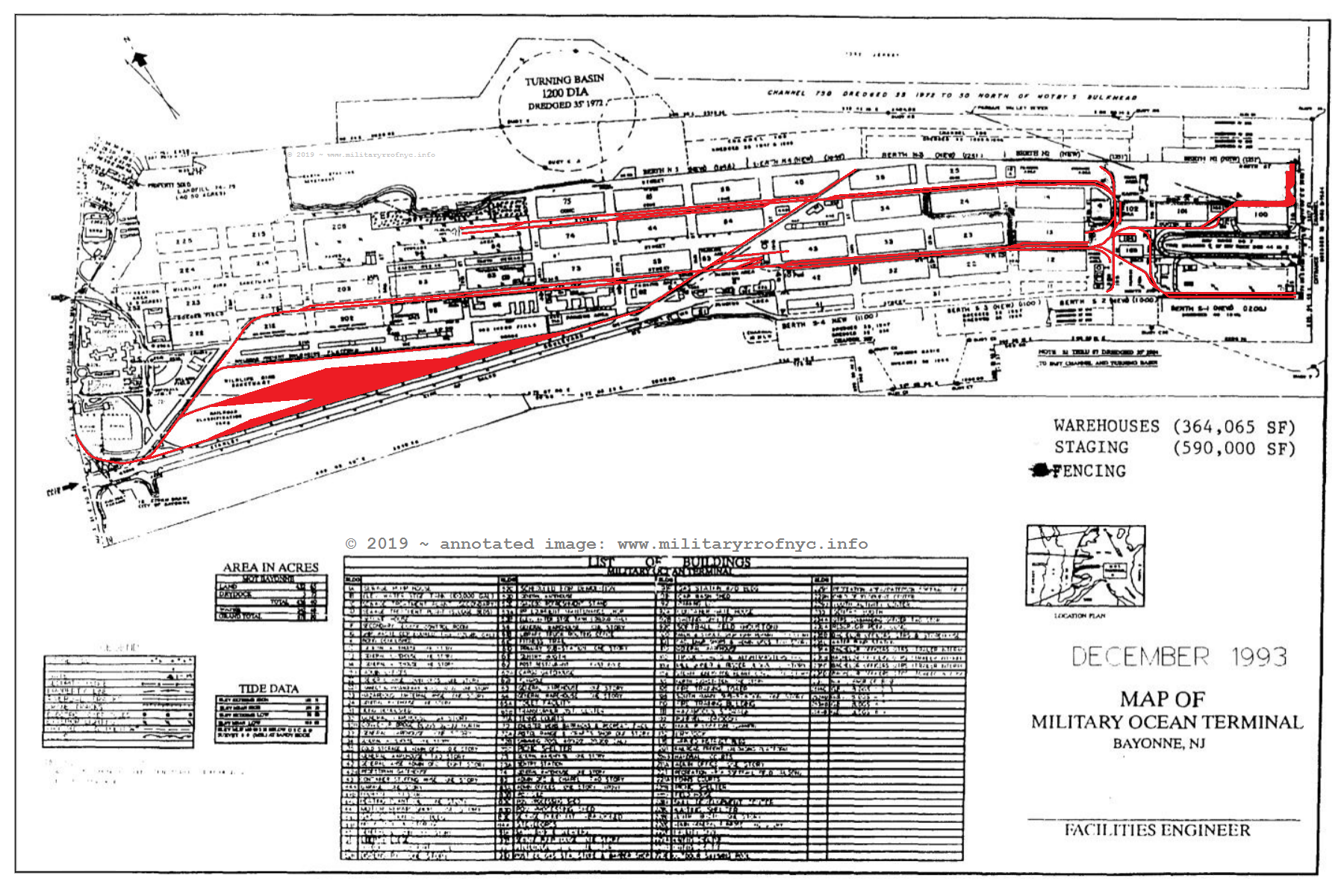 .
.
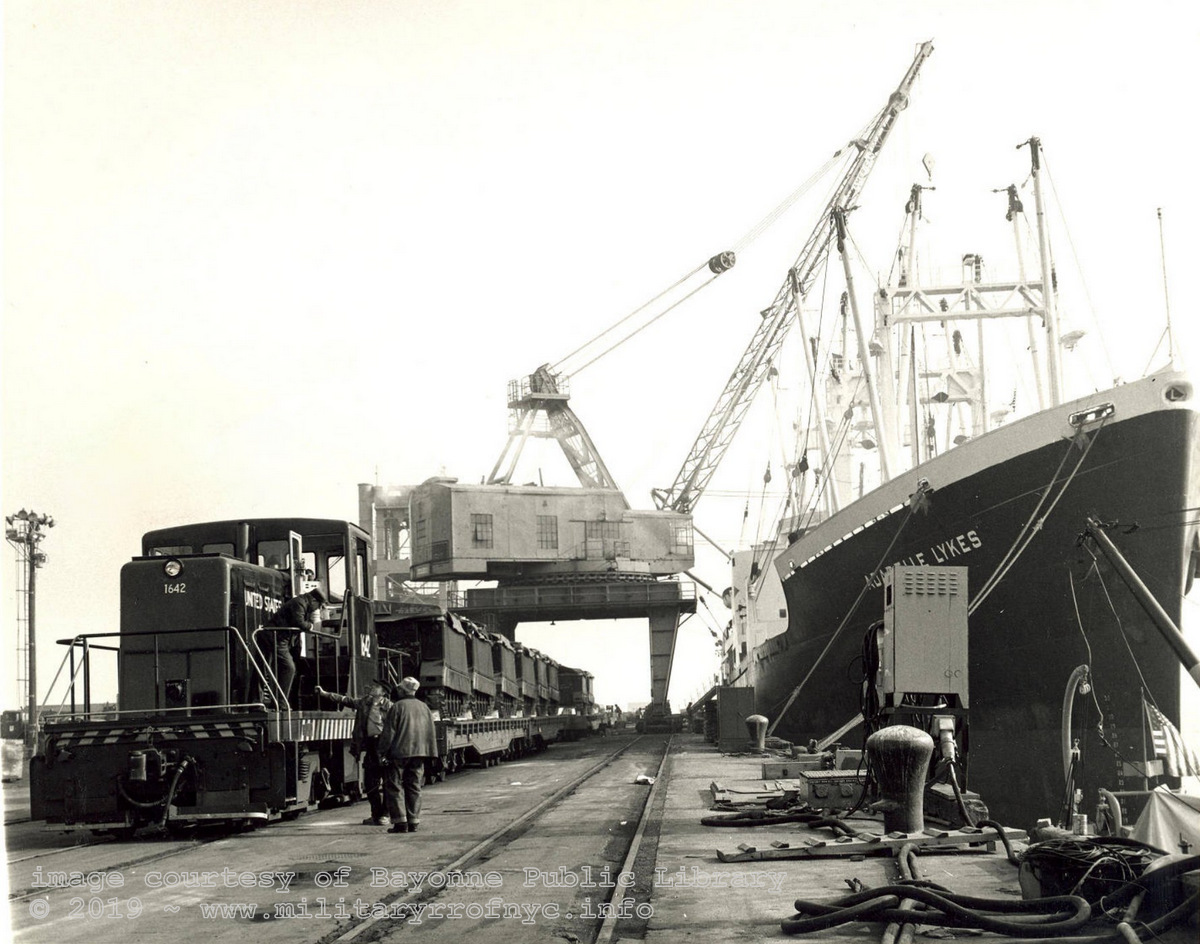 US Army #1642 - pierside with M113 Armored Personnel Carriers on flatcars, being loaded to "Adabelle Lykes" - 1967 at Military Ocean Terminal - Bayonne; Bayonne, NJ US Army photograph image courtesy of Bayonne Public Library Digital Archives © 2019 ~ www.militaryrrofnyc.info added 24 May 2019 |
| . . |
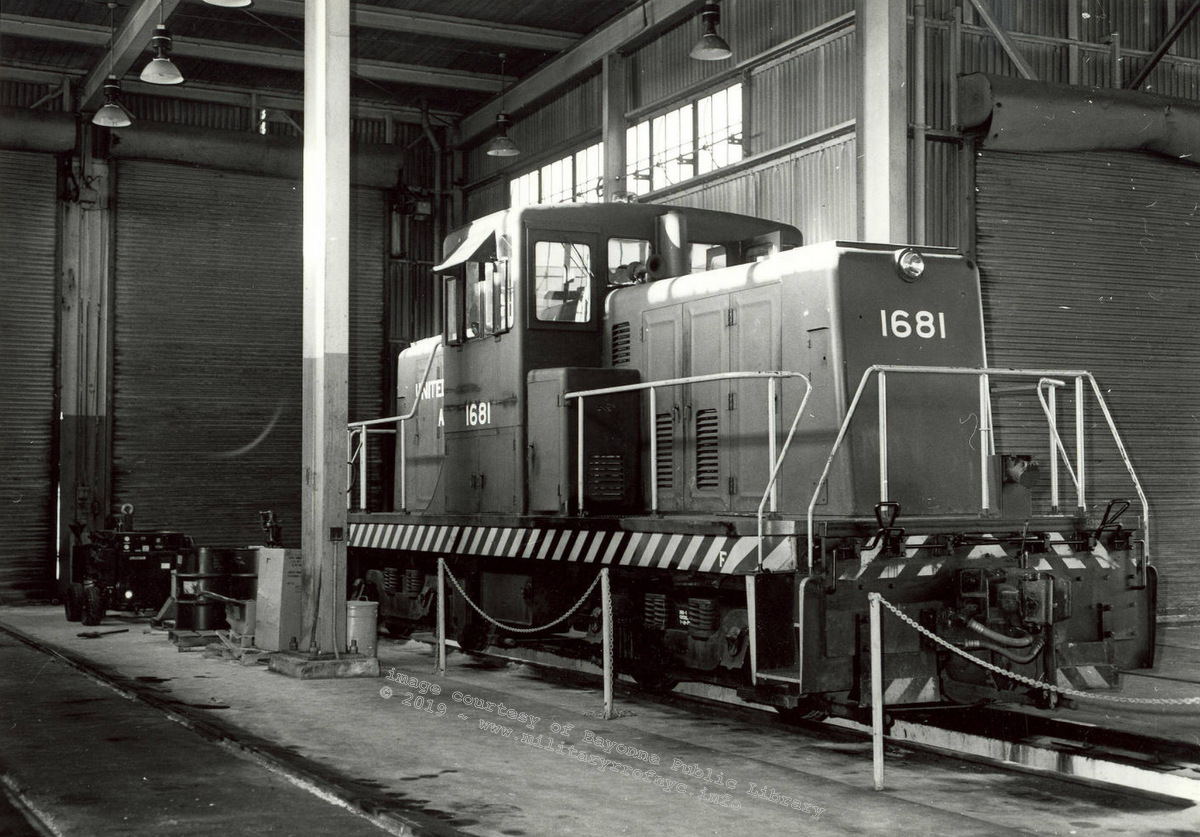 US Army #1681 - in enginehouse at Military Ocean Terminal - Bayonne; Bayonne, NJ - undated US Army photograph image courtesy of Bayonne Public Library Digital Archives © 2019 ~ www.militaryrrofnyc.info added 24 May 2019 |
.
.
.
Military Ocean Terminal - Bayonne
Locomotive Roster
All locomotives known to have operated at Military Ocean Terminal - Bayonne were standard gauge.
Please note the following roster does not contain locomotives
for export or shipment overseas. These are only the locomotives known
to have assigned to or operated within the Military Ocean Terminal - Bayonne.
builder |
c/n |
build date |
model | wheel arrangement |
wheel dia |
acquired |
number / name |
previous owner / military operating location | disposition |
notes |
ref |
| Vulcan | 4331 | 9/1941 | 0-4-0T | new | 100 | ||||||
| Vulcan | 4332 | 9/1941 | 0-4-0T | new | 101 | ||||||
| GE | 15038 | 9/26/1942 | 44 ton | B-B | 33” | new | 65-00008 | Becker Sand &
Gravel, Senter Plant, Lillington, NC Becker Sand & Gravel, Wolf Trap Plant, Blenheim, SC 1968 Brownsville Sand & Gravel #4, Brownsville, TX |
Caterpillar D-17000 (2) 380hp B-B-88/88-4GE733 |
||
| GE | 15131 | 10/26/1942 | 44 ton | B-B | 33" | new | USN #7 65-00007 |
ordered as Denver & Rio
Grande Western #44; diverted and delivered to US Navy # 7, Naval Supply Depot, Bayonne, NJ | Caterpillar D-17000 (x2) 380hp B-B-88/88-4GE733 |
||
| GE | 15283 | 7/7/1942 | 45 ton | B-B | 33” | new? | 65-00483 | Pittsburgh,
Allegheny & McKeesport #4 Marquette Cement Co #4, Security, MD 3/1964 |
Cummins HBI-600 (x2) 300hp B-B-90/90-2GE733 purchase order from Walter Kidde Construction Co., Port Newark, NJ for Federal Shipbuilding #4, Kearney, NJ for US Navy, Bayonne Naval Drydock Facility #1, Bayonne, N J |
||
| GE | 27859 | 3/31/1945 | 80 ton | B-B | new | US Navy, Brooklyn
Navy Yard Annex, Bayonne, NJ | Seaview Transportation #1, Cranville, RI | Cummins LI-600 (x2) 500hp B-B-160/160-4HM833 |
|||
| Whitcomb | 60636 | 8/1945 | 80DE7B | B-B | new | 65-00005 | |||||
| Whitcomb | 60637 | 8/1945 | 80DE7B | B-B | new | 65-00421 | |||||
| Whitcomb | 60681 | 11/1945 | 80DE11 | B-B | new | 65-00006 | |||||
| Whitcomb | 60682 | 5/1946 | 80DE11 | B-B | new | 65-00010 | |||||
| GE | 31349 | 7/18/1952 | 80 ton | B-B | 38” | "used" | 1642 65-00502 |
US Army #1642, New
Cumberland General Depot, New Cumberland, PA for US Army #1642, Brooklyn Army Base, Staten Island, NY; to Naval Supply Depot, Bayonne, NJ | US Army #1642, Ellwood Ordnance Plant, Ellwood, IL US Army #1642, Iowa Ammunition Plant, Middletown, IA US Army #1642, Red River Army Depot, New Boston, TX; 5/1999 |
Cummins NHBIS (x2) 470hp B-B-160/160-4GE747 | |
| GE | 31357 | 8/15/1952 | 80 ton | B-B | 38" | "used" | 1650 | US Army #1650,
Atlanta General Depot, Conley, GA for US Army #1650, Rossford Ordnance Depot, Toledo, OH; to US Army #1650, Tooele Army Depot, Tooele, UT to US Army #1650, Military Ocean Terminal, Bayonne, NJ | to US Army #1650, Joliet Ammunition Plant #K1398,
Joliet, IL to US Air Force #1650, Hill AFB; Ogden, UT; 3/1989 to US Air Force #1650, Clear Air Force Base; Anderson, AK; 1/1999. for? C&R Pipe; Fairbanks, AK to Napa Valley Railroad, #57; 12/2017 |
Cummins NHBIS (x2) 470hp B-B-160/160-4GE747 |
|
| GE | 31370 | 10/20/1952 | 80 ton | B-B | 38" | "used" | 1663 | US Army #1663,
Ogden Transportation Corps Depot, Arsenal, UT for US Army #1663, Joliet Arsenal, Joliet, IL | US Army #1663, Watervliet
Arsenal, Watervliet, NY US Army #1663, Letterkenny Depot, Chambersburg, Pa US Army #1663, Ft Eustis, Va |
Cummins NHBIS (x2) 470hp B-B-160/160-4GE747 |
|
| GE | 31384 | 11/28/1952 | 80 ton | B-B | 38” | new | 1677 | US Army #1677,
Ogden Transportation Corps Depot, Arsenal, UT for US Army #1677, Military Ocean Terminal, Bayonne, NJ – 12/1974 | to US Air Force #1677, Hill Air Force Base Ogden, UT; ca. 5/1989 US Army #1677, Red River Arsenal, New Boston, TX Wrecked in transit on KCS – to VMV (National Railway Equipment), Paducah, KY for rebuilding – 12/1991 | Cummins NHBIS (x2) 470hp -B-160/160-4GE747 | |
| GE | 31386 | 11/28/1952 | 80 ton | B-B | 38" | "used" | 1679 | US Army #1679,
Ogden Transportation Corps Depot, Arsenal, UT for US Army #1679, Watervliet Arsenal, Watervliet, NY US Army #1679, Military Ocean Terminal, Bayonne, NJ – 5/1992 | to Rocky Mountain Arsenal; Commerce City, CO; 9/1982 to US Air Force #1677, Clear AFB; Anderson, AK; 1/1999 Neosho Construction #41, Kansas City, KS | Cummins NHBIS (x2) 470hp B-B-160/160-4GE747 | |
| GE | 31388 | 12/5/1952 | 80 ton | B-B | 38" | new | 1681 | US Army #1681,
Ogden Transportation Corps Depot, Arsenal, UT for US Army #1681, Military Ocean Terminal, Bayonne, NJ | US Army #1681, Sunny Point Military Ocean
Terminal, Sunny Point, NC | Cummins NHBIS (x2) 470hp B-B-160/160-4GE747 |
Index:
Military
Railroads of the New York Metropolitan AreA | ||||
| EARLE N.A.D. N.W.S. EARLE | ||||
| FORT TOTTEN | Fort Terry | Fort Hancock / SANDY HOOK PROVING GROUNDS | ||
| . SIGN THE GUESTBOOK | ||||
.